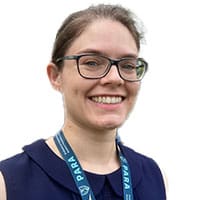Repurposing an existing chemotherapy drug could potentially slow down or stop the progression of ALS
A Canadian research team has identified a potential cause of amyotrophic lateral sclerosis (ALS) in some patients and discovered a chemotherapy drug that could be repurposed for treatment. ALS, a neurodegenerative disease also known as Lou Gehrig’s disease, causes progressive paralysis and usually leads to death within five years.
Published in the Journal of Biological Chemistry, the study reveals a mechanism behind the misfolding of two proteins, SOD1 and TDP-43, involved in ALS. Researchers found that tryptophan-172 in TDP-43 may trigger SOD1 misfolding, causing harmful protein clumping inside cells. By blocking tryptophan-172, they prevented SOD1 misfolding in human cell cultures.

Michele DuVal
“Our research question was, ‘Why are these two proteins misfolding and are they related in some way in causing the disease?’” explained Michele DuVal, a fourth-year neurology resident at the University of Alberta. DuVal received her PhD in the lab of co-author Professor Ted Allison before undertaking her MD.
Since blocking tryptophan-172 is not yet feasible in humans, researchers turned to targeting SOD1 directly. Using previous research and computer modelling, they identified the chemotherapy drug 5-fluorouridine as a candidate to prevent SOD1 misfolding. Tests on zebrafish, which share the same proteins, showed improved motor neuron function with the drug.
“We found that if we were able to stabilize the tryptophans and make the proteins less prone to misfolding, the fish were healthier,” said DuVal. Protein misfolding is common in ALS and other neurological diseases like Parkinson’s and Alzheimer’s.
The collaborative research involved experts from Alberta, B.C., Quebec, and the Netherlands, led by Allison and Professor Neil Cashman from the University of British Columbia. The identification of 5-fluorouridine as a drug candidate, already approved for human use, is a promising step. However, further research in cell cultures and animal models is needed to evaluate its effectiveness for ALS patients.
“We would be looking for functional outcomes, like how well the fish swim, how well the mice walk and do motor tasks, also how long they live,” DuVal explained. “This is a small piece of what is ultimately a very large drug development pipeline, but identifying candidates from existing approved drugs is an attempt to optimize time and resources while hopefully coming up with a drug that will be able to treat ALS.”
DuVal highlighted the progress made by the Canadian ALS research community since the 2014 Ice Bucket Challenge, which raised $20 million for research. She noted ongoing work by researchers like Sanjay Kalra at the University of Alberta and Michael Strong at the University of Western Ontario.
“It remains a devastating disease, but in terms of knowledge-building and clinical trial activity, we’re doing more than we ever have,” DuVal said. “I think it’s a critical time to keep the momentum going and build that hope.”
| Staff
The opinions expressed by our columnists and contributors are theirs alone and do not inherently or expressly reflect the views of our publication.
© Troy Media
Troy Media is an editorial content provider to media outlets and its own hosted community news outlets across Canada.



